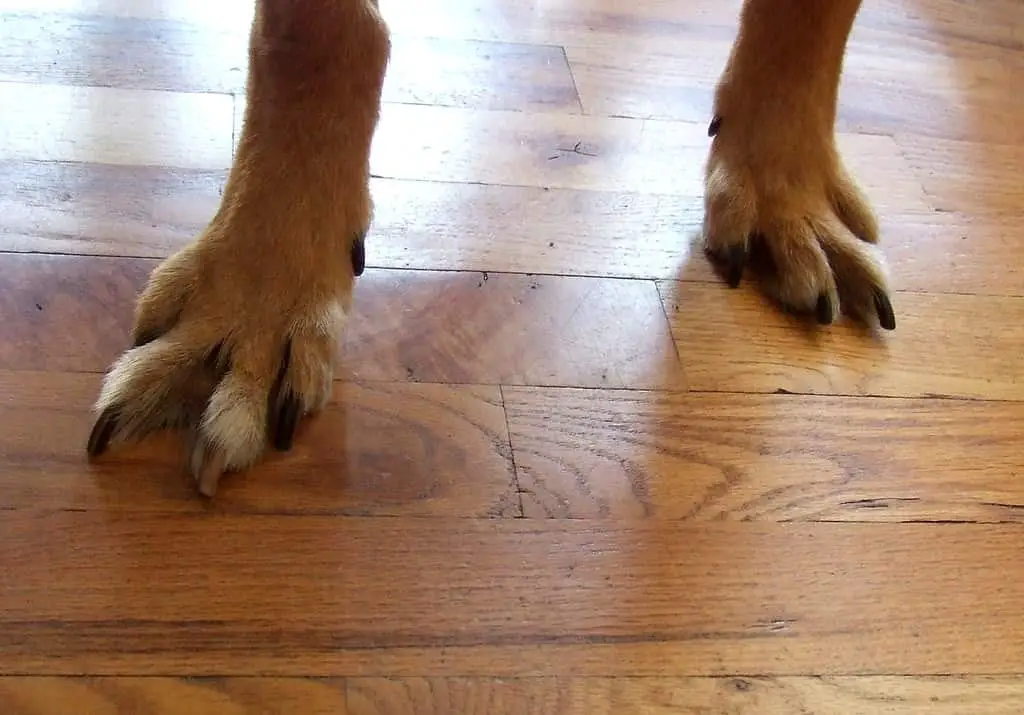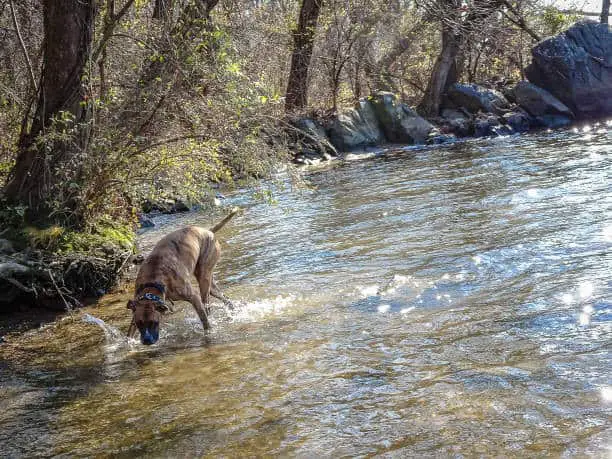Think webbed feet are limited to specific dog breeds? Think again! You’ll be amazed to learn that most dogs possess webbing between their toes, regardless of breed. It’s a fascinating feature that has evolved, much like the skin between our fingers.
Every dog has a small degree of webbing between their toes, but certain breeds exhibit more pronounced and prominent webbed feet due to genetic mutations and adaptations throughout generations.
Webbed feet in dogs serve various purposes beyond swimming ability – they offer better traction on slippery surfaces like ice or wet grass and help them easily navigate rough terrain.
Interestingly, some hunters prefer canine companions equipped with webbed feet for their enhanced hunting capabilities. Dogs exhibiting significant amounts of skin connecting each toe demonstrate true characteristics associated with having fully “web-footed” canines.
What Is Webbing In Their Paws?
Webbing in a dog’s paws refers to the presence of skin between their toes, connecting them. This trait is found in varying degrees across different breeds and has evolved as an adaptation to suit specific environmental needs or tasks.
Certain breeds exhibit more prominent and noticeable interdigital membranes. This extra amount of webbing can sometimes resemble that of aquatic animals like ducks or otters! Breeds such as Labrador Retrievers, Poodles, and Newfoundlands are known for having more webbing than other dog breeds.
The degree of webbed feet varies not only among breeds but also among individuals from the same breed. Observing your own canine companion’s paw structure can provide valuable insights into its ancestry and potential strengths in outdoor adventures or sports.

Why Do Dogs Have Webbed Feet?
Dogs have webbed feet to help them walk, run, maintain stability, and dig. However, most importantly, it aids their swimming ability.
It Helps To Walk/run And Maintain Stability.
One of the primary benefits of webbed feet in dogs is improved stability while walking and running. The extra skin between a dog’s toes acts like a natural snowshoe, allowing for better weight distribution on various surfaces.
Additionally, the increased surface area these webbed paws provide can enhance balance for breeds originally bred for hunting ducks and waterfowl. German Shorthaired Pointers are one such breed with notable webbing between their toes, enabling them to maintain their footing always.
It Is Much Helpful For Swimming
Webbed feet can greatly enhance a dog’s swimming ability, acting like natural paddles, propelling them quickly through the water.
In breeds such as the Labrador Retriever or Portuguese Water Dog, webbed feet are crucial for retrieving waterfowl and assisting fishermen.
In addition to making dogs more efficient swimmers, webbed feet instill a sense of stability on slippery surfaces commonly found around bodies of water.
For instance, Newfoundland breeds use their powerful limbs and rounded supportive toes to maintain balance while navigating icy cold waters or rocky shorelines.
During The Winter
Webbed feet in dogs can come in handy during the winter season. When the ground is covered with snow and ice, it can be challenging for dogs to maintain their footing and balance.
However, breeds with webbed paws, such as Newfoundlands, Portuguese Water Dogs, and Chesapeake Bay Retrievers, have an advantage due to the extra surface area provided by their webbing.
It helps them walk on snow without slipping or sinking into it. Furthermore, if you live in a region where ice forms on top of ponds or lakes during winter, your dog’s webbed feet also offer better traction when they go out onto frozen bodies of water.

For Digging
Dogs with webbed feet are not just great swimmers but also excellent diggers. The webbing in their paws gives them better traction and stability while digging deep holes.
Certain breeds, such as the Dachshund and Terrier breeds, were originally bred for digging, such as hunting small animals or vermin.
Newfoundlands and other water dogs were also trained to dig out fishing nets stuck underwater or on shorelines.
Dog Webbed Feet Vs. Without Webbed Feet
Let’s look at the table below for a better understanding of the distinctions between these two categories.
| Dog Webbed Feet | Non–Webbed Feet |
| Genetic mutation present in specific breeds | No significant genetic mutation related to webbing |
| Improved swimming ability | Swimming ability not significantly impacted |
| Better traction on slippery surfaces | Less traction on slippery surfaces |
| Includes breeds like Labrador Retrievers, Poodles, and Newfoundlands | Includes most dog breeds with no specific webbed feet traits |
| More likely to enjoy water sports and activities | May or may not enjoy water-related activities |
| Can navigate rough terrain more effectively | May struggle to navigate rough terrain compared to webbed feet breeds |
| Size and amount of webbing differ based on breed | No specific webbing size or amount |
| Can determine webbed feet by examining spaces between toes | Spaces between toes may be less noticeable or nonexistent |
This comparison between dog breeds with webbed feet and those without highlights the unique traits and characteristics that set these groups apart.
While not every dog breed possesses webbed feet, those have distinct advantages in certain situations, such as swimming and traversing slippery or challenging terrain.
13 Dogs That Have Webbed Feet
Here are 13 dog breeds with webbed feet, including popular breeds like Labrador Retrievers, Portuguese Water Dogs, and Poodles.
1. Newfoundland
The Newfoundland breed is known for its large size and strength, making them excellent swimmers. They are equipped with webbed feet to navigate the water quickly.
Originally bred as fishing dogs in Newfoundland, Canada, they would retrieve fishing nets and even rescue people from the icy waters of the North Atlantic. Their thick coat and webbed paws make these gentle giants an ideal companion for cold-water rescues.

2. Portuguese Water Dog
The Portuguese Water Dog is known for its webbed feet, which aid in swimming and diving. These dogs were originally bred to help fishermen by retrieving lost equipment and even herding fish into nets.
Their thick coat and water-resistant fur make them perfect for cold water work, while their webbed paws provide extra support and propulsion when paddling through rough currents.
Aside from their love of the water, Portuguese Water Dogs are also known for being intelligent, loyal, and playful pets. Their low-allergen coats make them ideal for those with allergies or asthma. Also, their curly hair requires special grooming care to avoid matting.

3. Otterhound
Otterhounds are a breed of dog that has prominently webbed feet. This feature makes them excellent swimmers, which was their original purpose in the 19th century when they were bred to hunt otters.
Otterhounds have large, strong paws with webbing between their toes, ideally suited for swimming and navigating through dense vegetation on land.
In addition to being great swimmers, this breed is known for having an outstanding sense of smell which aids in tracking prey on land or in the water.

4. German Shorthaired Pointer
The German Shorthaired Pointer is one of the most athletic and versatile breeds. Not only do they make great hunting dogs, but they also have webbed feet that enable them to swim with ease.
Their thick coats and webbed toes allow easy navigation in rough waters, making them ideal for hunting for waterfowl. The breed was originally developed in Germany during the 19th century to be an all-purpose hunting dog, possessing both speed and agility on land and water.
They remain popular for hunters today because of their endurance, loyalty, and adaptability to different environments.

5. Labrador Retrievers
The Labrador Retriever is one of the most popular dog breeds in the world. Not only are they loved for their friendly and obedient personalities, but Labradors also have webbed feet that make them excellent swimmers.
Their webbing helps them paddle through the water with ease and speed, making them perfect companions for trips to the beach. Labradors can also excel at hunting because their webbed feet provide better stability and grip on slippery terrain.

6. Dachshund
Dachshunds are a popular dog breed known for their long bodies and short legs, but did you know that they also have webbed feet?
While not all dachshunds have the same level of webbing as other breeds like Labrador Retrievers or Newfoundlands, their paws still offer some help in water-related activities.
Dachshunds were originally bred to hunt badgers and other small animals, so slightly webbed toes provided extra support for digging and navigating rough terrain.
Moreover, the paw shape of dachshunds allows them to move efficiently in a “down and out” motion when swimming rather than a paddling motion seen in dogs without webbing.

7. Chesapeake Bay Retriever
The Chesapeake Bay Retriever is a breed of dog originally bred for hunting ducks and other waterfowl in the icy waters off the coast of Maryland.
They have large, webbed feet with tough paw pads that help them navigate rough terrain while on land and provide better traction on slippery surfaces.
These dogs are muscular and strong, which makes them excellent swimmers too. This breed is known for its intelligence and loyalty to its owners, making it popular among pet parents who enjoy outdoor adventures.
Their webbed feet offer an advantage in swimming and diving activities and aid in their all-terrain abilities outdoors.

8. Irish Water Spaniels
The Irish Water Spaniel is a unique breed known for its curly coat and webbed paws. These dogs were originally bred as hunting companions, particularly for retrieving birds from the water.
Their large, rounded supportive toes and thick pads help them easily navigate cold and icy waters. Furthermore, the water-resistant coat of a Irish water spaniel keeps them warm in chilly conditions.
This breed’s distinctive appearance makes it stand out from other Spaniels, with its dense curls framing the face and often covering the eyes.

9. Weimaraner
Weimaraners are a dog breed known for their striking grey coat and athletic build. They also have webbed feet, which is no surprise considering they were originally bred as hunting dogs.
Their webbed feet help them to navigate through water and marshes during hunts, making them excellent at retrieving waterfowl.
Weimaraners are active dogs that enjoy exercise, so their webbed feet also come in handy when running on rough terrain or hiking over rocky landscapes.

10. German Wirehaired Pointers
The German Wirehaired Pointer is a breed with webbed feet originally bred for hunting. Their paw pads have thick, protective skin, and their toes are rounded and supportive, making them great all-terrain dogs.
The breed’s waterproof coat and large webbed feet help them navigate through icy waters during hunting waterfowl season. In addition to being exceptional hunters, these dogs make great companions for outdoor adventures due to their rough coats and low allergen coat.

11. American Water Spaniel
The American Water Spaniel is a breed known for its webbed feet. This breed was originally bred in the United States as a versatile hunting dog, particularly for waterfowl.
Their webbed feet allow them to quickly swim and retrieve game from the water.
American Water Spaniels have a waterproof coat which helps them stay warm and dry while hunting in cold waters. They are also recognized for their curly hair, from the liver to chocolate brown.

12. Poodles
Poodles are a breed of dogs with webbed feet, making them great swimmers. Originally bred as waterfowl hunting dogs in Germany, poodles possess large and curved toes with lots of furs between them.
These features allow the dog to paddle through the water more efficiently than other non-webbed breeds. Apart from their prowess in swimming, poodles also excel in several dog sports, such as agility and obedience trials, due to their intelligence and trainability.
This breed is also known for its hypoallergenic coat, making it perfect for pet owners who suffer from allergies.

13. Nova Scotia Duck Tolling Retriever
The Nova Scotia Duck Tolling Retriever, also known as the Toller, is a dog breed with webbed feet. This breed was originally developed in the 19th century to lure and retrieve waterfowl for hunters.
Tollers have a thick double coat that is waterproof and can withstand cold waters. Their webbed feet aid them when swimming, allowing them to paddle more efficiently.
Aside from their impressive hunting abilities, Tollers make great pets due to their affectionate and playful nature. They require regular exercise due to their high energy levels but enjoy outdoor activities such as hiking and swimming with their owners.

Dog Paw Webbing Isn’t All That Bad
Webbed feet provide numerous benefits to dogs, including improved swimming abilities, traction on slippery surfaces, and better mobility in rough terrain or while hunting.
Swimming Prowess
Dogs with webbed feet have a distinct advantage when it comes to swimming. Breeds such as the Portuguese Water Dog and the Newfoundland are known for their exceptional swimming abilities, partly thanks to their webbed paws.
The webbing between their toes acts like paddles, helping them easily propel through the water. Not only do webbed feet make swimming easier, but they also allow dogs to swim faster and longer distances.
All-terrain Dogs
Dogs with webbed feet are often referred to as “all-terrain dogs.” These breeds can navigate various terrains and weather conditions with their unique paws.
Their webbed feet make them great swimmers and allow them to traverse muddy, marshy terrain without getting stuck or slipping.
Webbed feet also serve as an advantage during colder months when snow and ice cover the ground. Dogs with this genetic mutation can move across icy surfaces faster than others since their webbing helps maintain traction on the slippery surface.
Digging
Webbed feet can be helpful for dogs when it comes to digging. Certain breeds with larger amounts of webbing on their paws, such as the Chesapeake Bay Retriever and the Newfoundland breed, are known for their adeptness at digging holes.
The extra webbing helps to provide better traction and support while excavating. Overall, having webbed feet offers many advantages for dogs, such as swimming or walking on slippery surfaces.
Stuck Snow
Webbed feet can be a lifesaver when maneuvering through the snow for dogs living in cold winters. When dogs walk on ice or packed snow, their paws lose traction and cause them to slip and slide.
However, webbing between their toes helps distribute their weight more evenly over soft surfaces like snow, allowing them to move around more effectively without sinking in.
This is particularly useful for breeds like the Newfoundland, originally bred to work in cold, icy waters and thick snowy terrain.
Health Concerns
Understanding that webbed paws are generally considered beneficial for dogs is essential. However, having excessively webbed toes can lead to potential health concerns.
For instance, water breeds such as the Portuguese Water Dog and American Water Spaniel have a higher risk of developing skin conditions between their toes due to their constant exposure to wet environments.
Fortunately, these issues can be easily prevented through regular grooming and hygiene practices. Pet parents must ensure that they keep their dog’s paws clean and dry after any swimming activities or walks in wet areas.
Trimming excess hair between the pads can also promote better air circulation around the paw area, reducing the risk of infections.
Show Ring Conformation Concerns
While webbed feet can be helpful for many dogs, they also present some challenges in the show ring. Dog breeders and judges prioritize specific physical traits when evaluating dogs for conformation shows, which include the shape and size of their paws.
Unfortunately, webbing on a dog’s feet can sometimes be considered a fault or count against them during judging.
For example, breeds such as the standard poodle are expected to have round “cat-like” feet with well-arched toes that do not have excessive hair between them.
On the other hand, breeds like Chesapeake Bay Retrievers were originally bred specifically for waterfowl hunting and require webbing on their feet to help them swim efficiently in cold waters.
What Are The Disadvantages Of Webbed Feet?
While webbed feet provide several advantages for dogs, there are also disadvantages.
- Webbing can make it difficult for some breeds to traverse rough or rocky terrain.
- Some breeds’ feet are built more for swimming than walking on land.
- Excess moisture between the toes caused by the webbing can lead to skin irritation and infections.
- If left untreated, this can be especially true in humid environments where bacteria thrive.
Despite these drawbacks, most breeds with webbed feet are well-suited for water-related activities such as swimming and diving. Many even excel in these pursuits thanks to their specialized foot structure and athletic abilities.
FAQ
Which dogs have no webbed feet?
Dogs not bred for swimming, such as sighthounds (e.g., greyhounds, whippets, and Salukis) and working dogs (e.g., German shepherds and border collies), typically have no webbed feet.
What breed of dog has turned out paws?
The breed of dog with turned-out paws is the Basset Hound.
How do I know if my dog has webbed feet?
To check if your dog has webbed feet, look at the skin between their toes. Your dog has webbed feet if the thick skin extends between the toes. The amount of webbing can vary from dog to dog, but most dogs with webbed feet will have some degree of webbing between all four paws.
Author Profile

- Product Reviews Specialist and Cofounder
-
Labradors have an extraordinary capacity for love and companionship, and my mission is to help you unlock their full potential. Hi there! I'm Sarah, a proud contributor to Labradorandyou, the go-to online resource for all Labrador Retriever enthusiasts. As a lifelong owner and avid admirer of these remarkable dogs, I bring a wealth of knowledge and hands-on experience to our readers.
One of my strongest beliefs is in the power of positive reinforcement training. I'm truly passionate about helping our readers build strong, positive relationships with their Labradors. Whether you're a first-time owner or a seasoned Labrador enthusiast, I aim to provide you with the resources and guidance to cultivate a bond that will endure a lifetime.
Also by the author
-
 Ai NewsDecember 30, 2024Everything You Need to Know to Prevent Online Shopping Bots
Ai NewsDecember 30, 2024Everything You Need to Know to Prevent Online Shopping Bots
-
 FAQNovember 17, 2023Why Is My Dogs Poop Yellow? 8 Reasons & Solutions
FAQNovember 17, 2023Why Is My Dogs Poop Yellow? 8 Reasons & Solutions
-
 ReviewsNovember 17, 2023Hill’s Science Diet Review [ Detailed ]
ReviewsNovember 17, 2023Hill’s Science Diet Review [ Detailed ]
-
 PuppyNovember 16, 2023How To Bottle Feed A Puppy? Facts You Can’t-Miss
PuppyNovember 16, 2023How To Bottle Feed A Puppy? Facts You Can’t-Miss





